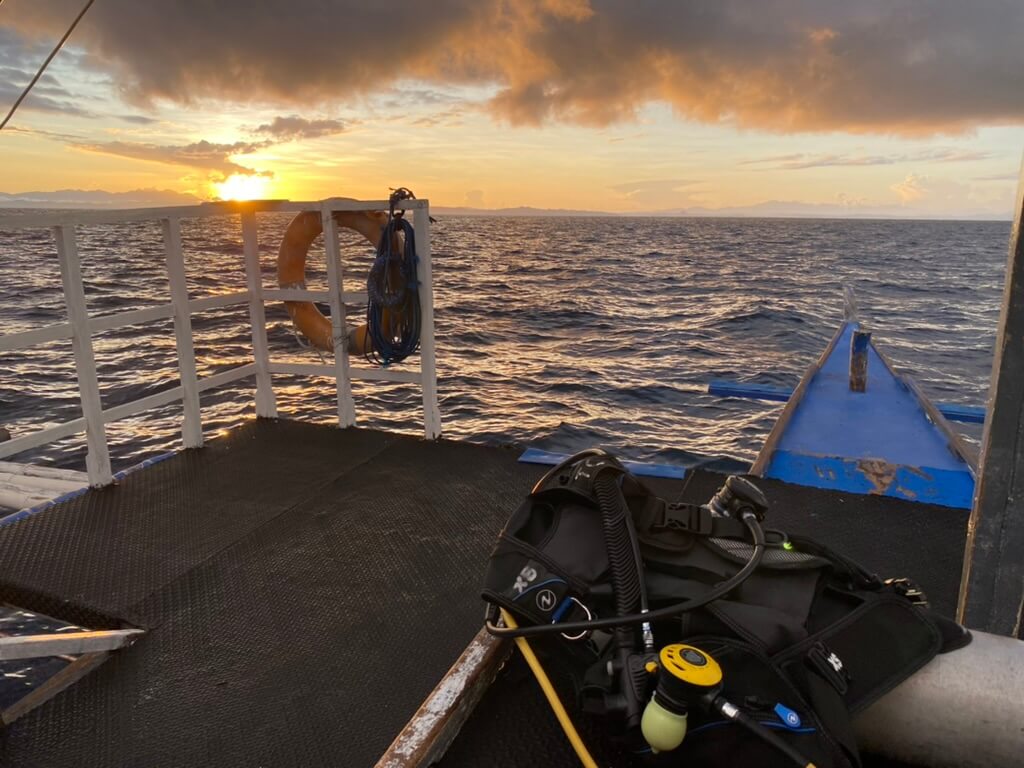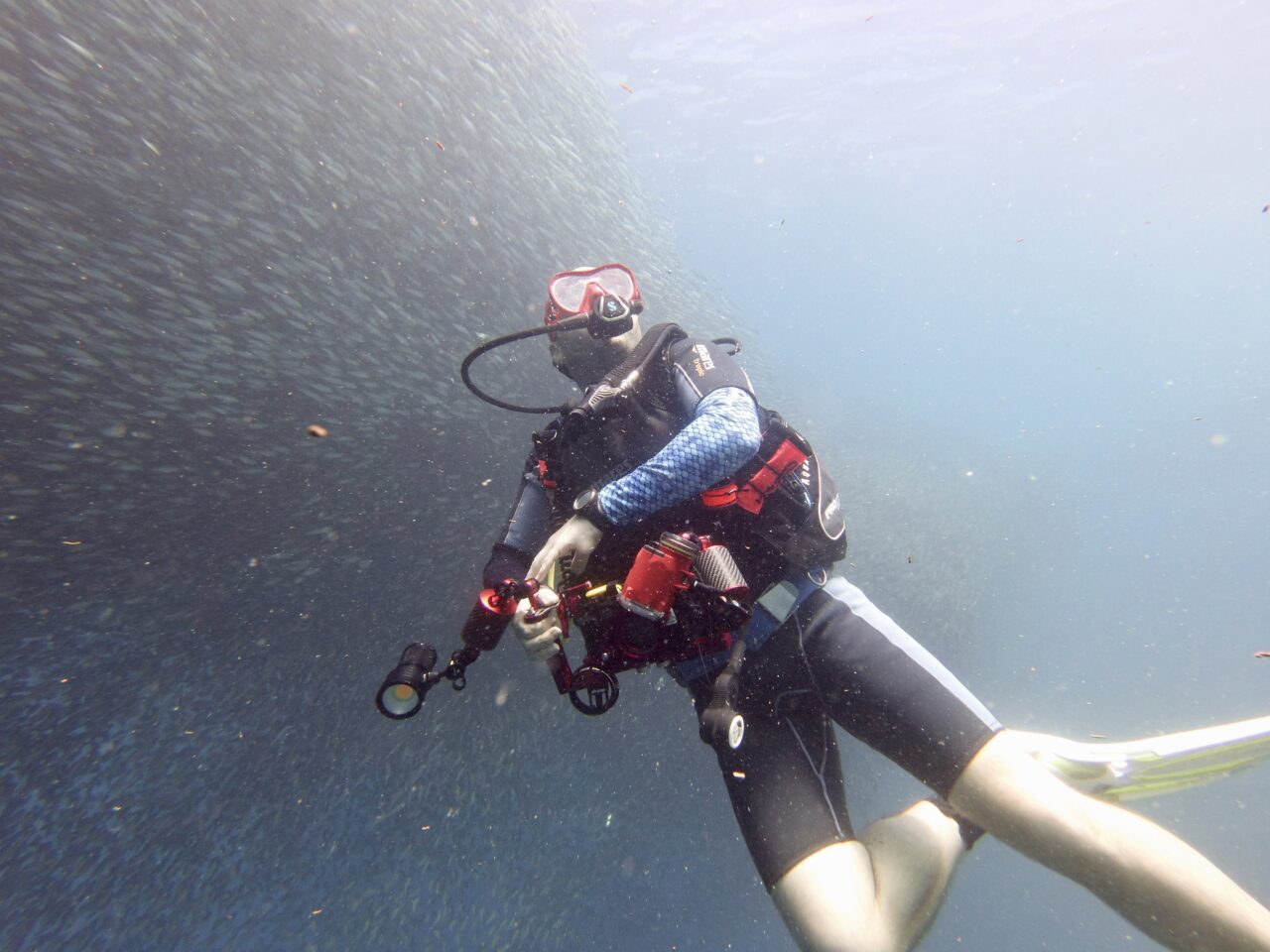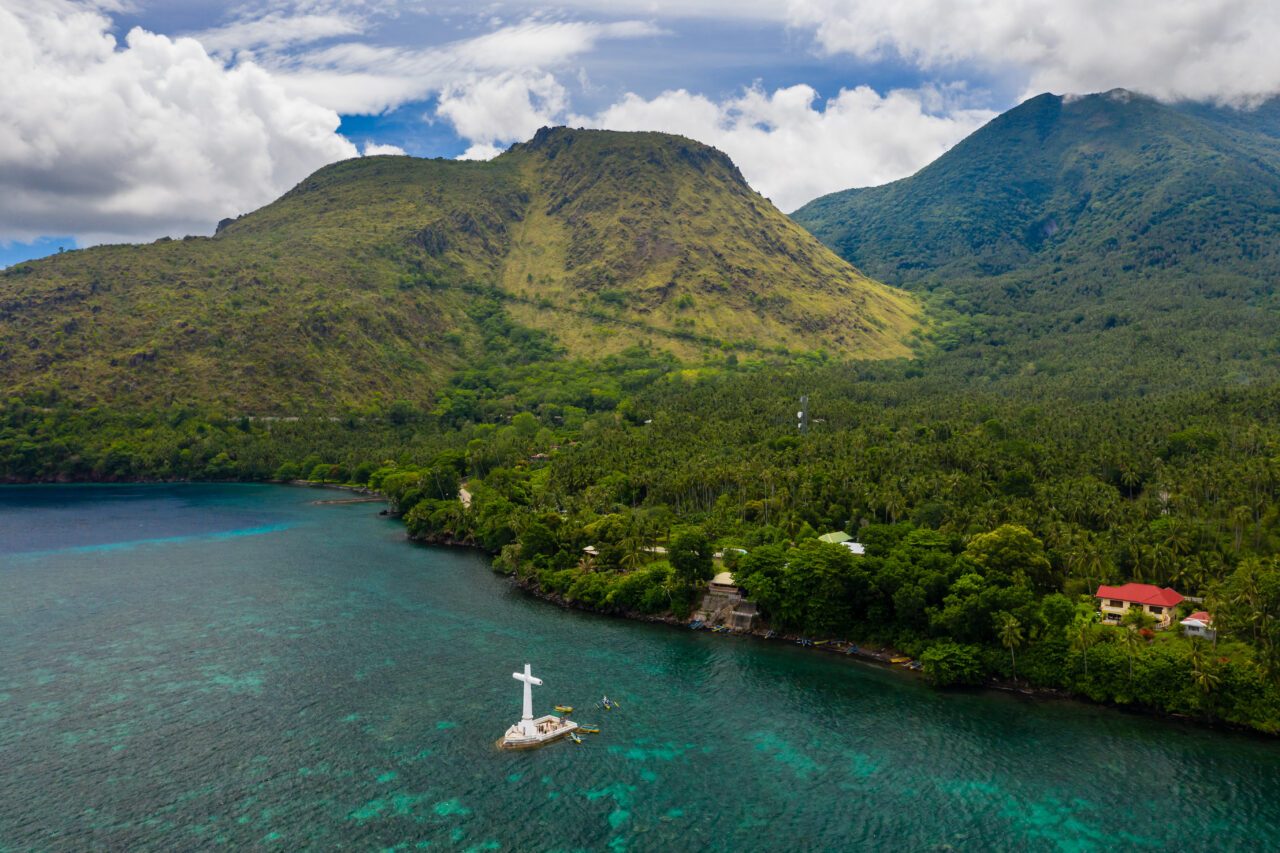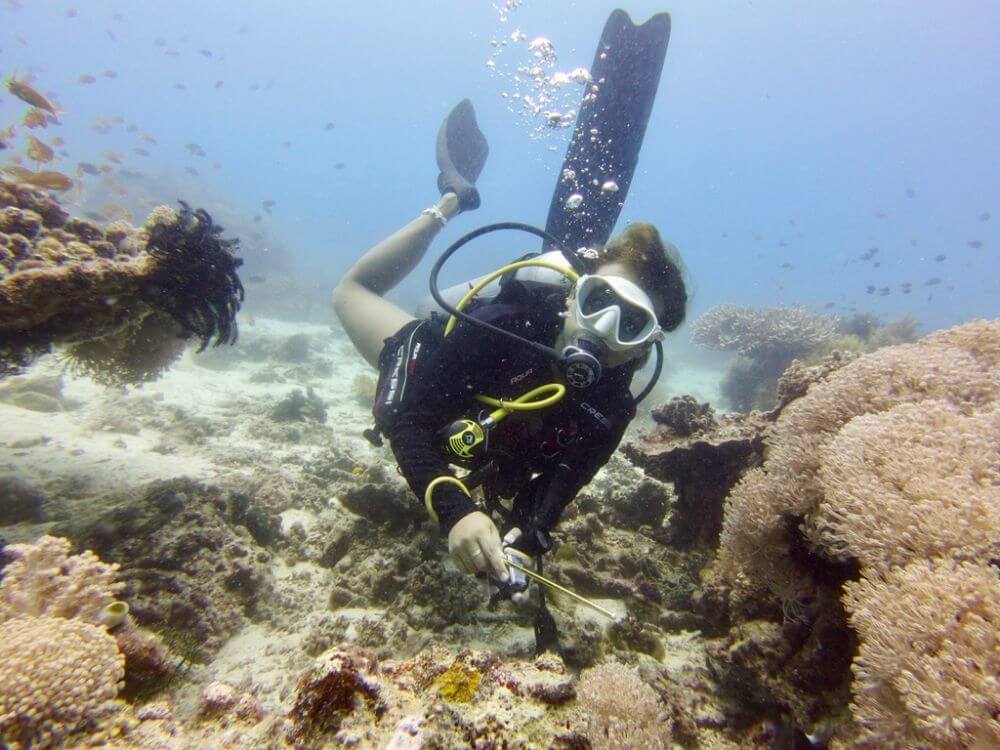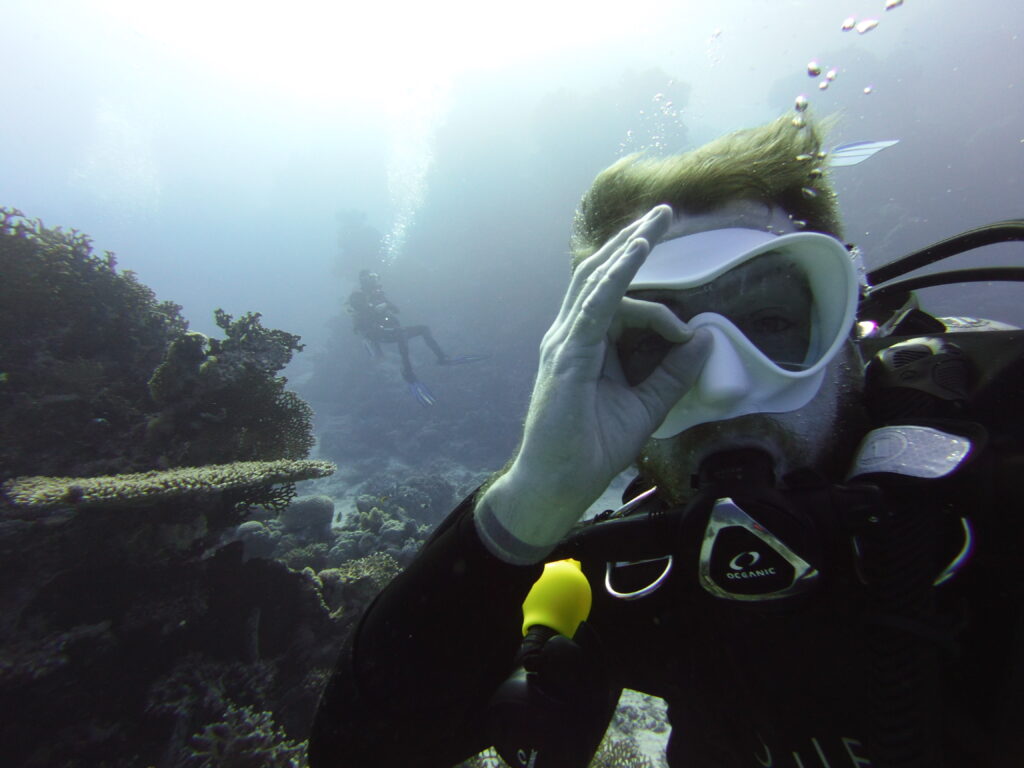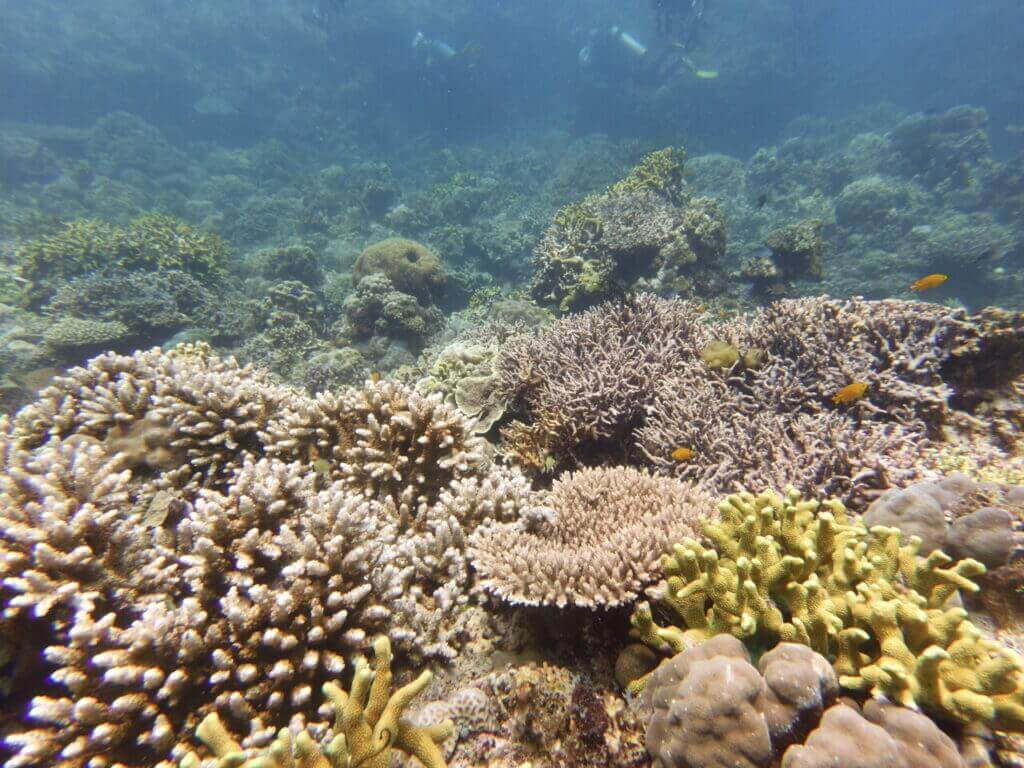
Consisting of over 7000 islands, the Philippines is renowned for jungle-strewn mountains and mighty volcanos, ancient tribes and white-sand beaches… and awesome marine life!
It is one of the easiest and cheapest places to travel in Southeast Asia as well as perhaps the all-time friendliest: with extremely laid back and fun-loving locals who are fluent in English.
For scuba divers; the Philippines is paradise. It’s budget-friendly, easy to travel and boasts an epic variety of unique diving experiences spread around its countless islands.
Dive amidst stunning coral reefs home to numerous turtles, sea snakes and reef fish as well as all manner of critters like frogfish, nudibranch and countless crustaceans.
Explore incredible Imperial Japanese Navy Shipwrecks from World War 2 and experience next-level muck dives with flamboyant cuttlefish, pygmy seahorse and blue-ringed octopus!
Come face to face with the elusive thresher shark (a guarantee so long as you visit the right place!) and look for other mighty pelagics; namely whale sharks and manta rays.
In this epic guide of gnarly awesomeness, I’ll tell you all you need to know about diving the Philippines – based on my own experience there spanning multiple trips over nearly 10 years.
We’ll talk about how the Philippines has changed; the best place to visit and lay out itineraries for which order to do them, no matter how little or how much time you have!
I’ll also cover travel logistics like where to stay, when to go and getting around as well as other adventure activities you can do on each island including waterfall jumping, caving and trekking.
So buckle up your bcd and pull down your scuba mask! After reading this, you’ll be ready to dive the Philippines like an absolute boss! Let’s do this!!
How to Use This Guide:
This main page links out to numerous mini-guides describing each dive destination in further detail with original videos and photos from my time there. From each mini-guide; you’ll find a link to another guide reviewing in detail the best places to stay there.
Most times you see bold blue text, it’s a link; clicking on it will open a mini-article in a new tab or jump to a section of this article. For example, see below where I’ve summarised Philippines diving highlights with links to the mini-guide for each location highlighted in bold blue. Dive / scroll down past this to see the full table of contents for this main article!
Highlights of Diving the Philippines:
- Awesome Coral Reef: El Nido & Siquijor plus Bohol & Puerto Galera
- Muck Diving: Dumaguete / Dauin plus Anilao & Puerto Galera
- World War 2 Shipwrecks: Coron
- Sardine Run: Moalboal
- Thresher Sharks: Malapascua
- Whale Sharks (possibly): Bohol and Tubbataha Reef and also El Nido
- Other Shark species El nido and Bohol plus Malapascua
- Manta Rays: El Nido and Tubbataha Reef (liveaboard)
Table of Contents
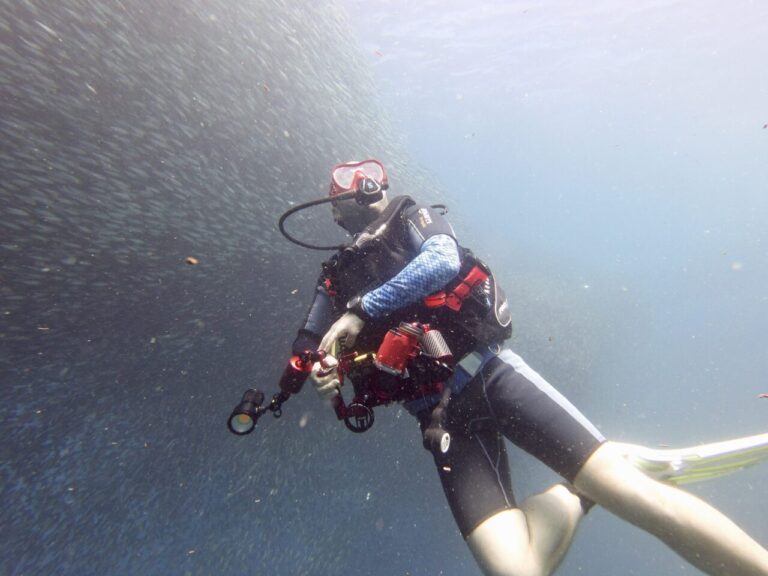
Philippines Diving Itineraries
Feel free to tweak, combine or amend these itineraries as you see fit, but I heartily recommend you check out ferry / bus / flight routes and schedules before you do!!!
Travelling around the Philippines can indeed be easy but is not as straightforward as it may seem. You cannot always easily get from one destination to another just because they appear close together on the map!
I have comprised the following routes, not just out of consideration for the best dive destinations combos but also whilst considering the most logical order to travel between them. (And remember never to fly within 24 hours of diving!!).
Dive the Philippines in 10 Days: Itinerary #1
You can squeeze an impressive variety of Philippines dive destinations into a short space of time, without even having to travel too far around the country.
Fly into Manila, the country’s capital and catch a 3 hour bus down to Anilao in Batangas Province. Anilao is famous for having some of the best muck diving in the world. Muck diving describes dive sites comprised of silt seabeds teaming with macro life: tiny cuttlefish, octopus, seahorses, frogfish, nudibranch and all kinds of other bizarre beings.
After Anilao, catch a 90 minute ferry across to Puerto Galera on Mindoro island. Puerto Galera has some of the most diverse diving in the Philippines; with superb coral reef that can be explored in both shallow waters and deep waters as well as on exciting drift dives and also several medium sized shipwrecks, deep-water night diving and a few more muck dives.
3 Weeks Diving the Philippines: Itinerary #2
3 weeks in the Philippines gives you time to explore some of the country’s most iconic destinations whilst also getting a little off-the-beaten track!
From Manilla or Cebu, take a 90 minute flight to Coron in Palawan. Coron is hailed as the best wreck dive destination in Southeast Asia with 10 Japanese Imperial Navy shipwrecks from World War 2. Whilst in Coron it’s also possible to dive with Dugong as well as in a freshwater lake.
From Coron take a 4 hour ferry to the visually stunning El Nido; which has dozens of dive sites comprised of superb coral reef as well as an underwater tunnel and the chance to see nurse sharks and manta rays.
Next, catch a short flight from El Nido to Panglao; a small island connected via bridge to Bohol which is famous for the stunning chocolate hills. Theres some superb diving around Panglao; with healthy reef, turtles, whitetip reef sharks and sometimes even whale sharks. For some extremely off-the-beaten-track diving in Bohol, head to Anda!
After this, grab a 2 hour ferry down south to the incredibly laid-back Siquijor; a more off-the-beaten track island, renowned for witchcraft and hosting incredible reefs, schooling milkfish, turtles and many macro critters like hairy crabs, pygmy frogfish and tiny nudibranch.
Then take a 50 minute ferry to Dumaguete city on the mountainous island of Negroes. Dumaguete is a busy city so you may prefer to stay in the quieter Dauin town a 30 minute ride away. Either way, the dive sites off the coast between Dumaguete and Dauin comprise superb off-the-beaten track muck dives.
From Dumaguete you can make a day-trip to dive the famous reefs of the nearby Apo Island. If not you can grab a 90 minute flight from Dumaguete airport back to Manila for your way out of the Philippines
1 Month Diving the Philippine’s Visayas: Itinerary #3:
Alright, Diving Squad listen up! This is it; a full blown month to penetrate deep into the heart of the Philippines and scuba dive the f*ck outta it! Are you ready?! Ooh-rah! Then let’s gooooo!! Move, move, move – dive, dive, dive!!!
Arrive in Manila and grab a 90 minute connecting flight to Cebu. From there, it’s a 5 hour journey up north to the tiny island of Malapascua. Malapascua is the best place in the world to see the the elusive thresher sharks with tails the same lenght as their bodies!
After Malapascua, make your way back to Cebu and take a 3 hour bus ride to Moalboal on the southwest of Cebu island; a bustling seaside town popular with partying backpackers and famous for it’s “sardine run” where you can dive amidst a huge school of local sardines at depths of less than 33ft / 10m.
From Moalboal, some people take a 90 minute taxi ride down south to Oslob. Here you can dive with dozens of whale sharks; however they’re being fed chum which is detrimental to their migratory patterns and breeding so I gave this one a miss. Instead, I recommend returning to Cebu and from there grabbing a 2 hour ferry down to Bohol.
With spectacular coral, countless turtles, giant barracuda, whitetip reef sharks, muck diving and sometimes even whale sharks, Bohol is my favourite dive destination in the Philippines I spent over 6 months here using it as a homebase in 2023!
From Panglao, if you want to get really off-the-beaten track and don’t mind a 6 hour long journey from Panglao, head to Camiguin, a small, rarely-visited island with seven volcanos that you can climb and some nice off-the-beaten track diving with schools of jackfish and very rarely visited drift dives over soft coral gardens far out to sea.
Or, take a two hour ferry from Bohol to the incredibly chill (and also off-the-beaten-track) island of Siquijor which is renowned for witchcraft, caves, waterfalls, stunning coral, schooling milkfish and plenty of macro critters. In my opinion, if you could only do Siquijor or Camiguin, Siquijor is the better option!
From Siquijor grab a one hour ferry ride to Dumaguete for incredible, off-the-beaten-track muck diving with all kinds of weird and wonderful macro critters. If you have time, take a day trip to the famous reefs of Apo island.
After all this, it’s probably time to grab a 90 minute flight from Dumaguete airport to Manila…but if you you somehow still have days to spare, take a 2 hour flight to Busuanga in Coron; for next level Japanese shipwrecks from World War 2! After that you can head down to El Nido for the best coral reef in the country!
Alternative Itinerary #4: Philippines Liveaboard
If you have a high budget, you’re an experienced diver and you want to explore what many consider to be one of best diving destinations in all of the Philippines, consider embarking on a liveaboard around the legendary Tubbataha reef; where pristine coral reef and endless sharks, rays and big pelagic fish await.
Tubbataha Reef is only accessible via liveaboard and less than a dozen different liveaboards visit this area so it is a truly off-the-beaten-track dive destination where you will see few other divers. Check out the main page on Philippines liveaboards for more info!
Best Places to Dive in the Philippines
We’ll now take a more in-depth look at each of the best dive destinations of the country. Over the course of the various scuba odysseys I’ve been making around the Philippines since 2016, I’ve been lucky to dive these places.
You can find more information on each by clicking the link at the end of each summary to go to the mini-guide I created for it.
#1 Bohol (FAVOURITE!)
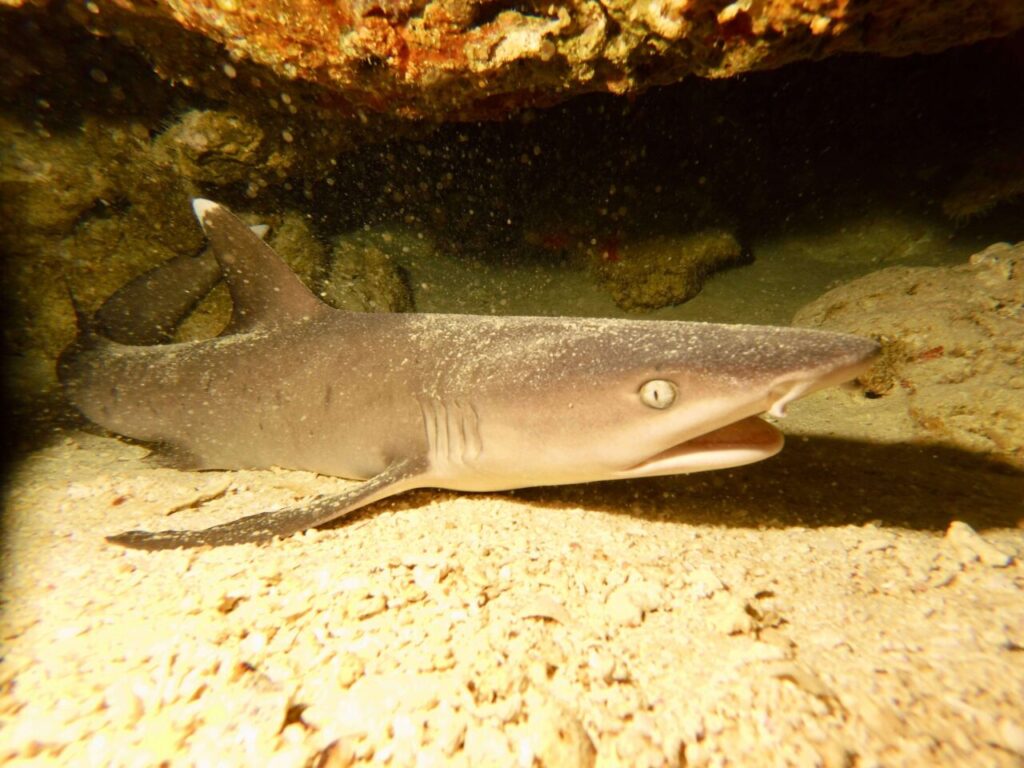
Why Go: I’m a huge fan of Bohol. Over 2023, I spent over half a year living on Panglao, a small island connected to the southwest tip of Bohol via bridge.
Panglao is the launchpad to the most famous dive sites of Bohol around the nearby tiny islands of Balicasag and Pamilacan where divers can discover awesome coral reef that’s home to turtles, sea snakes and critters like frogfish, seahorses and nudibranch. There’s also resident whitetip reef sharks and giant barracuda as well as occasional whale shark sightings.
Panglao offers a nice mix of chilled vibes with happening scene. It’s not as hectic as some other Philippines destinations but along Alona beach there’s still a lively buzz in the evenings.
A 2 – 3 hour journey from Panglao lies Anda where some truly off-the-beaten-track diving awaits with nice coral and muck dives; very few tourists make it there.
Bohol island also has some epic sights to behold on land including the famous chocolate hills as well as waterfalls, tarsiers, caves and danao adventure park with its huge bungee swing.
Getting There: You can fly into Panglao airport or if coming from nearby Philippines islands catch a ferry to Tagbilaran port from which is a 20 minute tricycle ride onto Panglao.
When to Go: Bohol experiences less of an intense rainy season than other parts of the Philippines, meaning it’s more suitable to dive all year round. Dry season technically runs between December – May; which is when dive conditions are best… but even from June – November; there’s less rainfall compared to other parts of the Philippines.
- Check out my Main Page on Diving Bohol
- Or skip to the Best Places to Stay in Bohol for Divers
#2 Coron, Palawan (BEST WRECK DIVING)
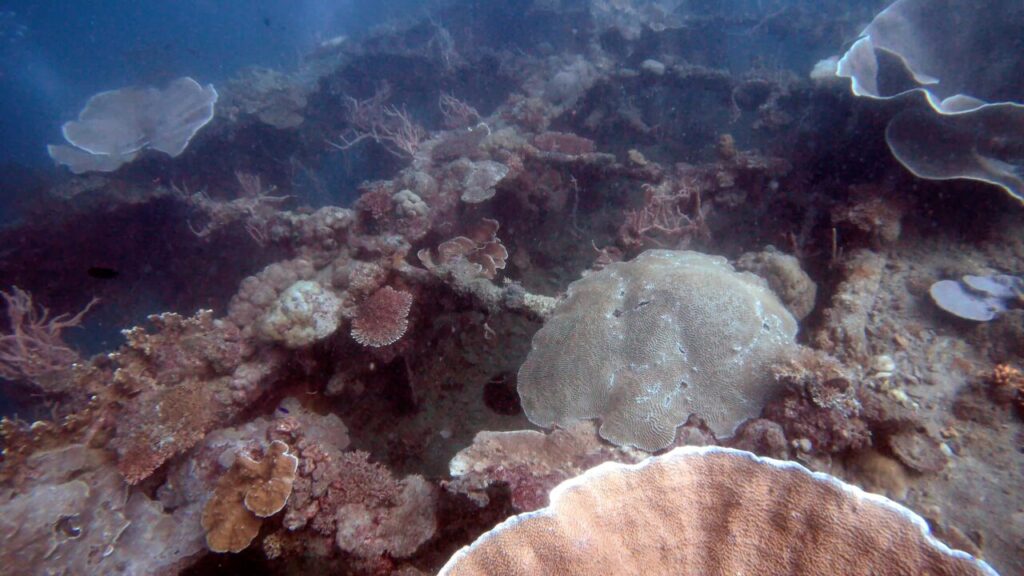
Why Go: Located in Palawan; one of the most beautiful and iconic parts of the Philippines; Coron is hailed as the greatest wreck dive destination in all of Southeast Asia.
There are 10 Japanese World War 2 shipwrecks; most are over 333 feet (100 meters) long and are coated in colourful hard coral on the outside; with components such as anti-aircraft guns and seaplane cranes still visible.
However, it is within that the real adventure lies; these wrecks can be penetrated and the larger ones have many decks, compartments and rooms to explore where you’ll see engines, boiler rooms and even an air pocket.
Coron is famous for its limestone cliffs and freshwater lakes; one of which can be dived, there are some awesome sightseeing tours around these landmarks. You can also make a day trip to North Busuanga to dive with Dugong!
Getting There: To reach Coron, you need to fly to Busuanga (aka Coron) airport and then catch a 50 minute van ride to Coron town. Or take a 4 hour ferry from El Nido.
When to Go: December – March usually offers the best water visibility; it is generally only during these months that you can easily see the wrecks form the outside. October – June is the next best period whereas July – September is rainy season when visibility is often at it’s lowest and currents their strongest.
- Check out my Main Guide to Coron Diving
- Or skip to Where to Stay in Coron for Divers
#3 Malapascua, Cebu (THRESHER SHARKS!!)
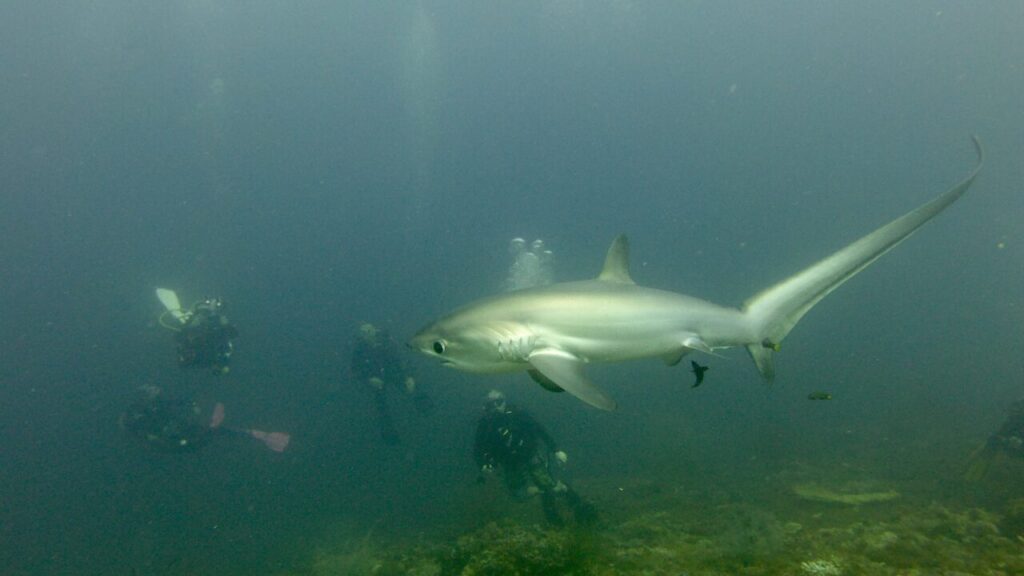
Why Go: Malapascua may be a little harder to reach than many other Philippines destinations but it is oh so worth it. It’s the best place in the world – nay, the only place where you’re practically guaranteed to see thresher sharks; those curious looking sharks with bodies of up to 10ft / 3m and long, pointy tails the same length again!
There’s also some very local dives along coral walls; a sunset dive to see mating mandarin fish and half day trips to nearby Gato Island for awesome soft coral gardens, an underwater tunnel and pygmy seahorses.
Malapascua itself is a truly tiny island with a land area of just 148 hectares; there’s some nice beaches and snorkeling here but not much else to do. Some people love the laid-back vibes others are very much ready to leave after a few days! Either way, it’s definitely worth visiting for those thresher sharks.
How to Get There: Generally you’ll start from Cebu city; you can fly into Mactan airport there or catch a ferry to Cebu from nearby islands. From Cebu it’s a 4 hour bus ride to Jaya port and then a 45 minute ferry to Malapascua.
When to Go: The very best time to go is typically between January to April, however anytime between January to October and water visibility is still pretty decent. Try to avoid November – December when visibility reduces drastically.
- Check out my Main Guide to Malapascua Diving
- Or skip to Where to Stay in Malapascua
#4 Anilao, Batangas (AWESOME MUCK DIVES)
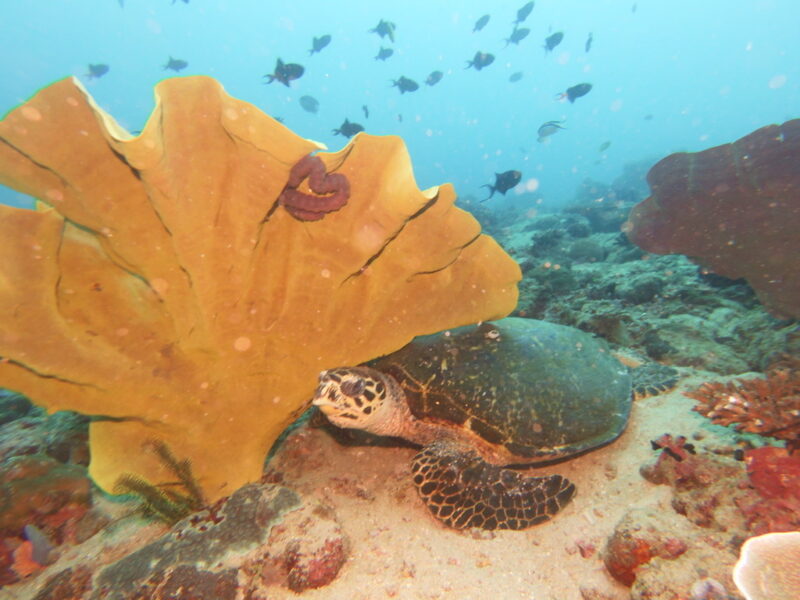
Why Go: Located in Batangas province of South Luzon, Anilao is one of the easiest to reach dive destinations in all of the Philippines, it takes just a 3 hour bus ride from Manila to get there.
It is also a rather unique dive destination as whilst most Philippines dive locations are defined by magnificent coral, turtles and reef fish, Anilao is famous for having some of the best muck dive sites in not just country but the entire world.
Muck diving is a term coined by scuba divers to describe dive sites defined by sandy or silty bottoms, devoid of much coral but home to an impressive myriad of macro critters. On just one good muck dive you can see colour-changing cuttlefish, seahorses, pipefish, pygmy frogfish and all kinds of nudibranch!
Getting There: Just fly into Manila, the capital of the Philippines and grab a 3 hour bus to Anilao.
When to Go: You can dive Anilao year round, however the best months are typically regarded as November / December and April / May.
- Check out my Main Guide to Anilao, Batangas Diving HERE
#5 Tubbataha Marine Park (LIVEABOARD)
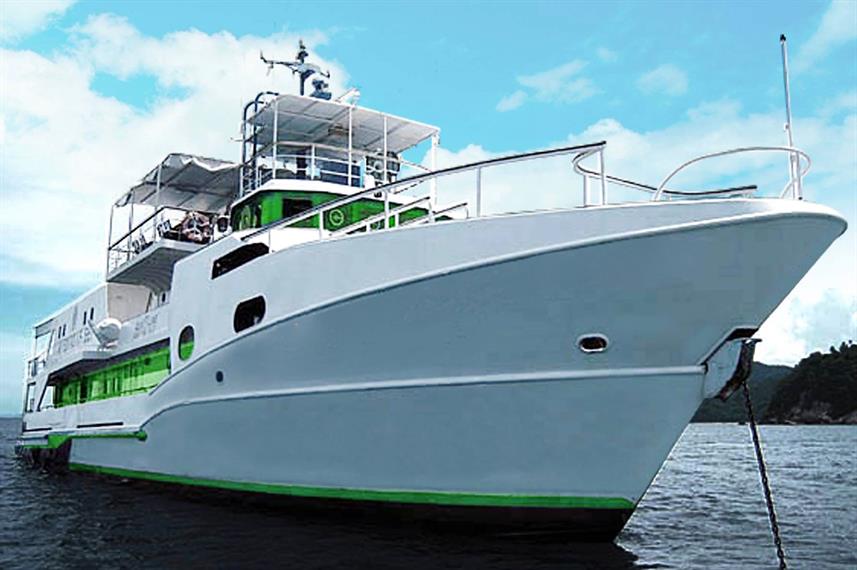
Why Go: If you have a high budget and want to experience the very best diving of the Philippines, consider embarking on a liveaboard to Tubbataha Marine Park.
Accessible only to liveaboards, the remote Tubbataha Marine Park encompasses an area of 96.828 hectares of protected coral reefs that are home to a myriad of different shark and ray species as well as huge schools of pelagic fish and countless turtles, critters and reef fish.
Situated on the Cagayan Ridge, comprised of extinct underwater volcanos, it was declared a world heritage site in 1993 by UNESCO due to representing “a unique example of an atoll reef with a very high density of marine species”.
How to Get There: Generally Philippines liveaboards bound for Tubbataha depart from Puerto Princesa in Palawan, which you catch a 90 minute flight to from Manila.
When to Go: Unlike other parts of the Philippines, there is a specific dive season: March – June, when water conditions are at their calmest and visibility at its highest. Generally, Tubbataha liveaboards don’t operate outside of this period.
Check out my Main Page on Philippines Liveaboards.
#6 Puerto Galera, Mindoro (BEST VARIETY)
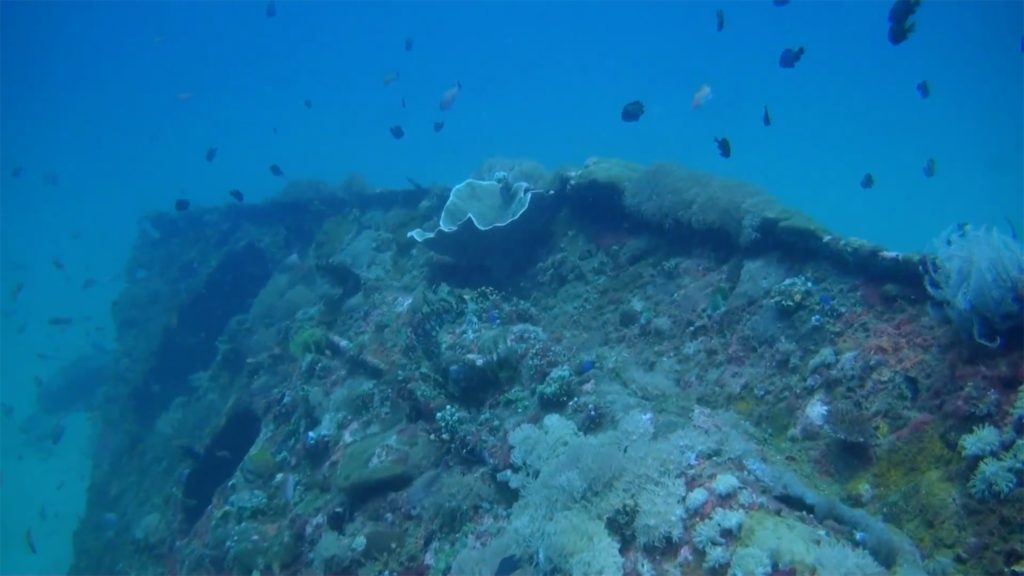
Why Go: Ah Puerto Galera! I got stuck here for 6 months during the 2020 lockdowns and over that time completed my divemaster. But that’s a separate story.
Puerto Galera is a stellar place to go diving in the Philippines; it is easy to reach and offers a kickass variety of diving. The coral reef here is awesome; you can explore it across a range of shallow and deep dives in both calm waters an on fast paced drift dives.
There are four medium sized shipwrecks that make superb entry level wrecks for divers as well as a couple of very nice muck dives, teaming with all kinds of macro critters. It’s also a great place to go night diving. Plus, you can make day trips to the nearby Verde Island for incredible deep wall dives.
Getting There: Fly into Manila and grab a 3 hour bus ride down to Anilao in Batangas province. From here it’s a 90 minute ferry across to Puerto Galera.
When to Go: June to October has the best visibility, however you can dive Puerto Galera year round as due to it’s location its fairly sheltered from typhoons.
Check out the Main Guide to Puerto Galera Diving
#7 Siquijor (CHILLED VIBES, AWESOME CORAL )

Why Go: Siquijor is a very laid-back, more-off-the-beaten-track destination in the Philippines. It has some of the best coral reef in the country; having been largely unaffected by the 2021 typhoons that took out much coral elsewhere.
Around the drift dive site sunken island, you have a great chance of seeing schooling milkfish, the national fish of the Philippines. There are also many turtles, reef fish and various critters such as frogfish, scorpionfish fish and nudibranch. Several dive sites also offer good muck diving. Lucky divers may sometimes see whitetip sharks around “the cave” dive site.
Siquijor has a reputation for witchcraft; however the vibes here are only good. The “witches” are actually healers who you can visit for a mystical ceremony.
Although it’s a fairly small island, there are many other cool activities to do including waterfalls, caving, sky-diving and riding a scooter up to mount bandilaan for a jaw-dropping panoramic view of the island.
Getting There: You can fly into Siquijor airport or catch a short ferry ride there from nearby islands like Bohol.
When to Go: December – April is dry season and sees the best water visibility and calmest conditions. That said you can dive all year round!
- Check out my Main Guide to Siquijor Diving!
- Or skip to Where to Stay in Siquijor for Divers.
#8 Moalboal, Cebu (SARDINE RUN!!)
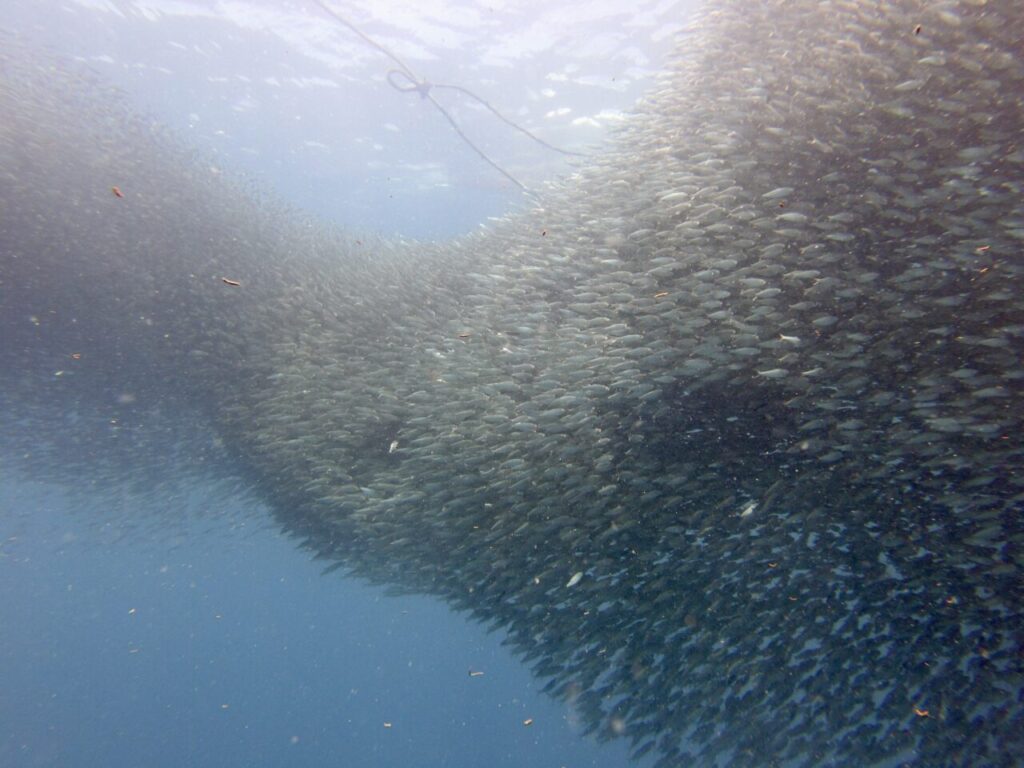
Why Go: Moalboal is a lively seaside town that is popular with partying backpackers. There are some nice dive sites here with decent coral, although a fair bit of the reef was taken out during the 2021 typhoons. All the same, divers can spot many sea snakes, turtles, nudibranch and reef fish.
The most special thing about Moalboal is the dive site: “sardine run”; where scuba divers, free-divers and snorkelers alike can swim amidst a huge local school of local sardines at depths of just 33 feet / 10 meters. Moalboal is the only place in the Philippines where swimming with sardines like this is guaranteed!
Dive sites are easy; relatively shallow and in weak to non-existent currents making Moalboal a great place for beginners. In fact, after Koh Tao in Thailand, Moalboal is the second most popular place in Southeast Asia to get scuba certified.
There’s also a couple of really cool activities like caving and viewpoint treks – without a doubt the funnest is the canyoneering in which you spend half a day jumping off the tops of waterfalls!
Geting There: You’ll need to get to Cebu city; either by flying into Mactan (Cebu) airport or catching a ferry to Cebu city port from nearby islands. From Cebu city, it’s a 3 hour bus ride to Moalboal.
When to Go: January to May is dry season during which time water visibility is at it’s greatest, however you can dive Moalboal year round!
- Check out the Main Page on Moalboal Diving
- Or take a look at Where to Stay in Moalboal
#9 El Nido, Palawan (INCREDIBLE CORAL REEF!)
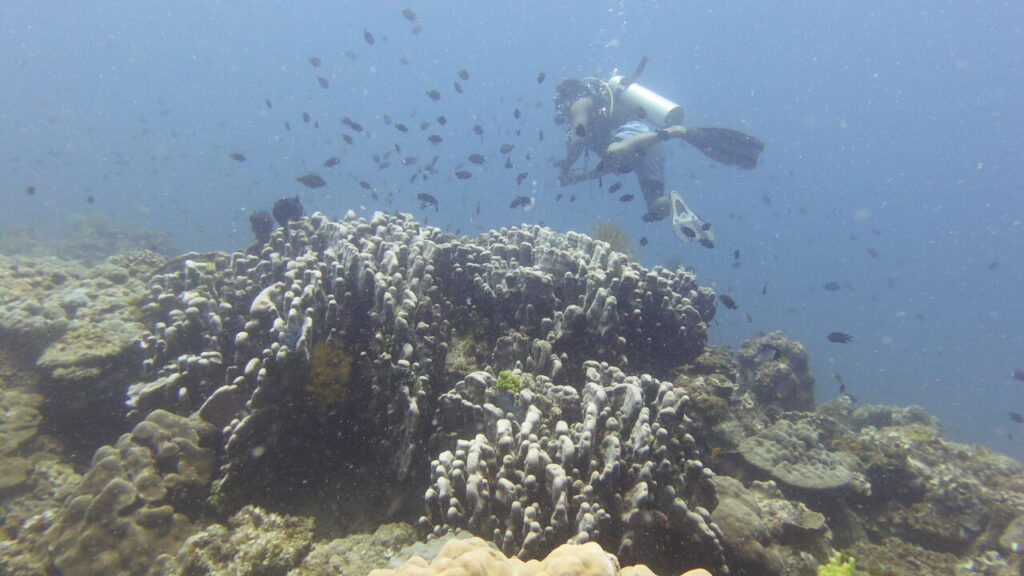
Why Go: El Nido has some seriously underrated diving! The coral reef here is simply the best in the country; it was sheltered from the 2021 typhoons and nowhere else did I see such extensive and intricate hard coral structures. There are countless reef fish, turtles, nudibranch, ribbon eels and schooling giant barracuda.
A favourite dive site is Dilumacad Tunnel; a long tunnel through helicopter island which opens out into a spacious cavern where ceiling holes let in light that glimmers off schooling fish and small transparent crustaceans and mollusks. Around El Nido Bay, lucky divers also have the chance to see nurse sharks and, whitetip reef sharks and eagle rays!
If you drive 50 minutes to the extremely quiet, off-the-beaten track village of Sibaltan, you can also dive with manta rays.
El Nido is one of the most popular destinations in the Philippines for the stunning, jungle-coated limestone cliffs that rise out of the sea to form many small islands which you can go beach-hopping around. The main town is extremely busy: being a backpacker party-hub mecca.
Getting There: Catch a 4 hour ferry there from Coron or fly into Leo (aka El Nido) airport.
When to Go: The best months to dive El Nido are June and July; which are later in the year compared to optimal time for other parts of the Philippines. However you can also dive El Nido all year round.
- Check out my Main Guide to Diving El Nido.
- Or read about Where to Stay in El Nido
#10 Dumaguete / Dauin, Negros (MUCK DIVES)
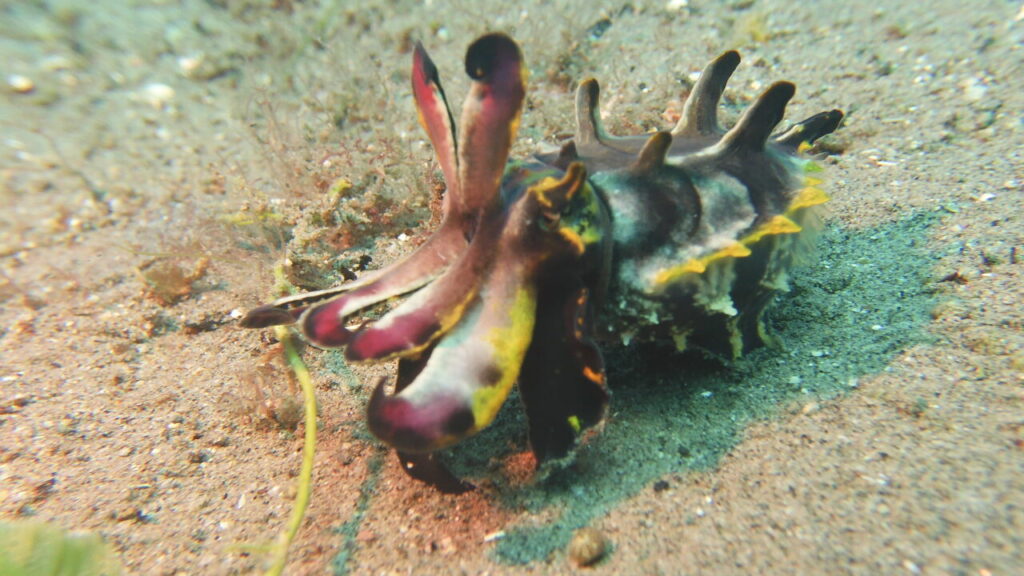
Why Go: There are many awesome muck dive sites between Dumaguete city and the quieter Dauin town. On just one dive I saw 3 cuttlefish, 2 seahorses, 5 pipefish, 7 nudibranch, 3 pygmy frogfish, 3 mantis shrimp and a school of over over 100 squid! A few dive sites also have some very nice coral reef and schools of giant barracuda.
Compared to Anilao; the most famous muck dive destination of the Philippines, the dive sites between Dumaguete and Dauin are far more off-the-beaten-track and you will see few other divers.
I will say that Dumaguete is a very busy city without much charm, whereas the quieter but sprawling Dauin is also lacking in any kind of vibe or variety of places to eat. However, Negros island itself has some of the best volcano and mountain trekking in all of the Philippines, many of which start from nearby Valencia. There’s also some cool waterfalls to check out.
Getting There: Fly into Dumaguete airport or catch a 2 hour ferry from Bohol or a 1 hour ferry from Siquijor.
When to Go: December to April is dry season during which time water visibility at its best but you can dive all year round.
- Check out my Main Guide to Diving Dumaguete / Dauin!
- Or skip to Where to Stay in Dumaguete / Dauin
#11 Apo Island (EXCELLENT CORAL)
Why Go: The tiny Apo Island is well known for having some of the best coral in the Philippines with masses of reef fish and countless turtles. You can easily visit it on a day trip from Dumaguete / Dauin or Siquijor or you can choose to stay on Apo Island itself (although its basic yet expensive!).
This is a peaceful and fairly off-the-grid dive destiantion of the Philippines. There’s a few lighthouses to visit around the island and some nice beaches but not much else to do. With frequent powercuts and limited wifi it’s a great place to go for a digital detox!
Getting There: You can arrive via ferry from Siquijor or, more commonly, Dumaguete.
When to Go: October – May is the main dive season, with the months of December to April generally offering the greatest water visibility and calmest surface condiitons. However, you can dive all year round.
#12 Camiguin (MOST OFF-THE-BEATEN-TRACK)
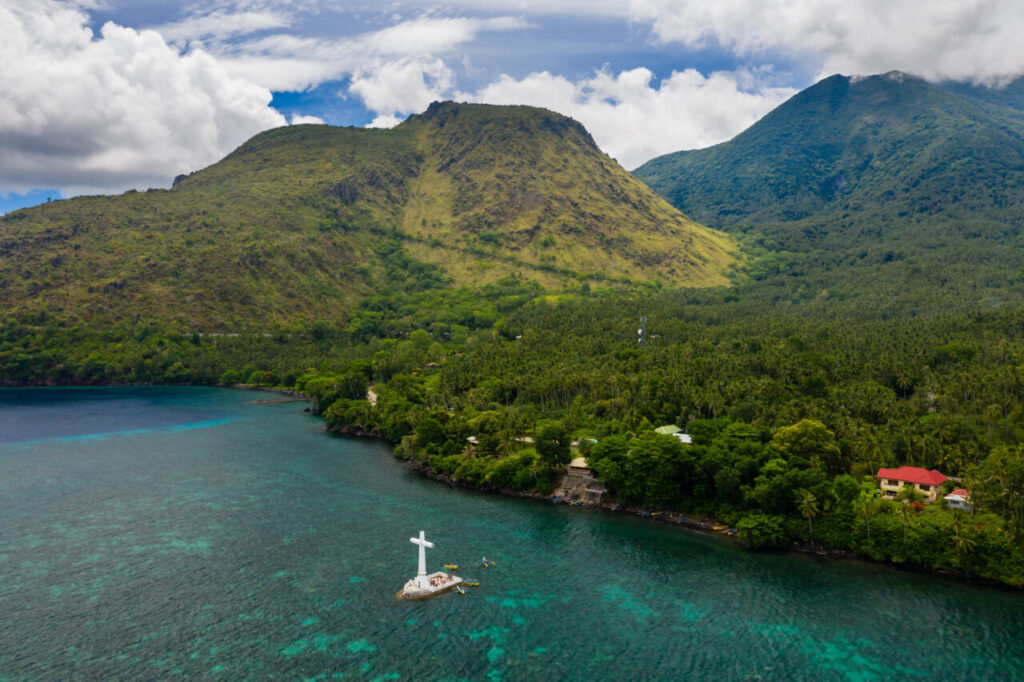
Why Go: If you truly want to dive somewhere in the Philippines where few others have ventured, consider Camiguin; a small island 10km off the north coast of Cagayan de Oro of Mindoro.
Nicknamed the “Island Born of Fire” it is a visually stunning place with the highest volcano to land density of any island in the world, with seven volcano; several of which can be trekked for epic views and camping.
There are some nice dive sites with many reef fish and schools of jackfish as well as turtles, sea snakes and nudibranch amidst some epic underwater volcanic rock formations as well as over some extensive soft coral gardens far out to sea. However, I will say that Camiguin is more expensive to dive than other Philippines destinations and hard to get to.
Gettting There: Fly in to Camiguin airport (most commonly reached from Cebu/ Mactan airport) or catch a 90 minute ferry across from Cagayan de Oro – or a 4 hour ferry from Jagna port in Bohol which takes two hours to reach via bus from Panglao.
When to Go: April – November is dry season and offers the best visibility and calmest seas. December – March is monsoon season; diving conditions are at their worst during these months. However, you can technically dive Camiguin year round.
- Check out my Main Guide to Diving Camiguin
Where to Stay: Philippines Diving Resorts
When it comes to picking a place to stay at any given dive destination in the Philippines, you have 2 broad options:
- Stay at a Philippines Dive Resort: This is the most expensive option. Whilst there are some mid-priced dive resorts in the Philippines; there are also some extremely luxurious options. Many dive resorts have their own in-house dive centre, restaurant and bar and may have other facilities like a spa, fitness centre and swimming pool. Philippines diving resorts are often set a little away from the main tourist-hub of an area; in a more peaceful setting; they may have private beaches or even be located on private islands.
- Stay at a Hostel or Homestay near a Public Dive Centre: This is the most affordable option and is also a good way of meeting backpackers and travellers. It will be important to stay in a hostel or homestay near the main tourist hub as this is where most public dive centres, restaurants and bars are located. In all the location guides outlined below, only hostels / homestays in good locations for divers have been recommended…
So without further adue, check out the links below to the Accommodation Guides for Divers I’ve created for each major Philippines dive destination:
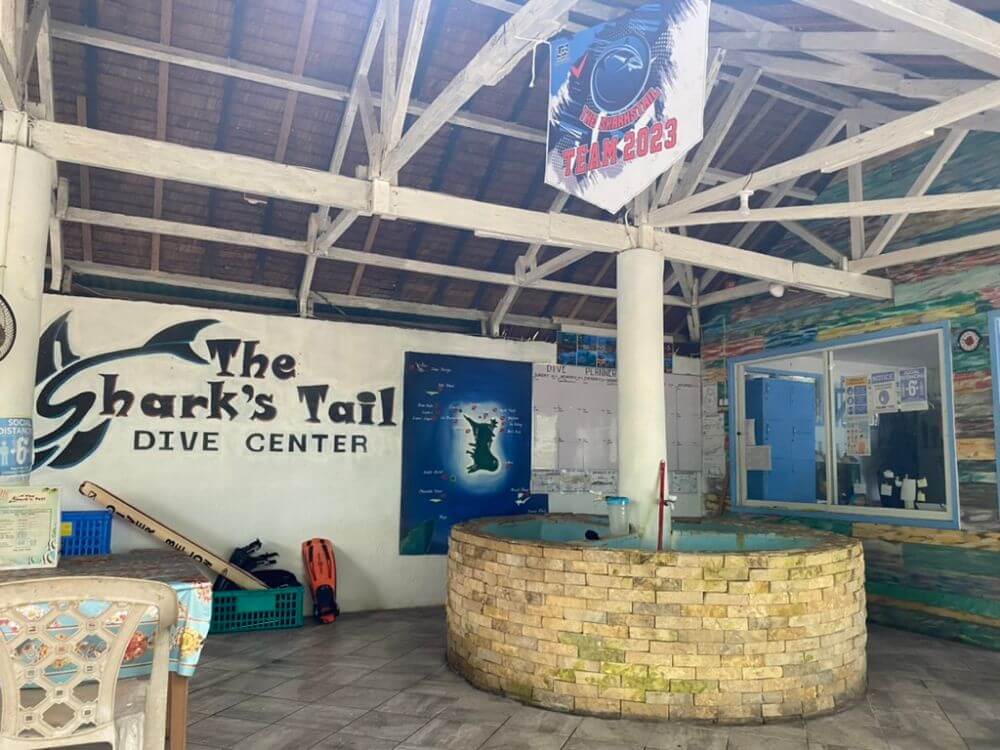
Philippines Diving Season
First of all; let’s talk about wet season vs dry season; it’s something most tropical parts of the world experience including the Philippines and it significantly affects diving conditions.
Now if you quickly google “Philippines dive season”, the answer you’ll get is that whilst most of the Philippines can be dived year round; December – April marks dry period with the best dive conditions whereas June – November marks rainy season with lower water visibility and increased water swell.
However, this is actually not terribly inaccurate; for you see whilst December – April does indeed mark dry season for some areas of the Philippines (Type I), a more in-depth analysis of weather patterns across the archipelago shows there are actually 4 types of climate each with their own seasonality across the Philippines:
- TYPE I: This is the pronounced season climate where generally December – April does indeed mark dry season and June – November marks wet season. For some vague reason; most websites talking about diving season in the Philippines incorrectly apply these conditions to the entire country – but this is not the case! However, destinations that do fall under Type 1 include Anilao, Coron, El Nido, Tubbataha and Apo Island. That said; even then it’s not entirely clear-cut for if you ask any local diver in El Nido they will tell you that the best time to dive there is actually June and July. Also, Tubbataha can only be dived from mid-March to mid-June.
- TYPE II: Areas that fall under Type II are described as having no distinct dry season but as experiencing pronounced rainfall from November to January. This applies to Camiguin.
- TYPE III: Seasons are not very pronounced, such areas may be fairly dry from November – April and wet for the rest of the year. This applies to Puerto Galera, Moalboal and Dumaguete / Dauin.
- TYPE IV: These areas are especially hard to predict; often they’re described as Type 1 online but in reality they can experience fairly even rainfall throughout the year but this can vary from year to year; it may be very dry when everywhere else in the country it is wet and vica versa. Areas that fall under Type IV include Bohol, Siquijor, Malapascua. Locals will tell you not to dive Malapascua over November – December when visibility is said to be drastically reduced.
Perhaps as little as ten years ago, one could more reliably predict the dry and wet seasons of Southeast Asia; however climate change has significantly affected weather patterns around the world; making them far harder to predict.
This is very much something I’ve experience whilst in the Philippines. I’ve dived places that are very dry for months on end when they’re supposed to be wet and I’ve also dived in places that are very rainy when it’s supposed to be dry! So the information above is only a loose indicator…
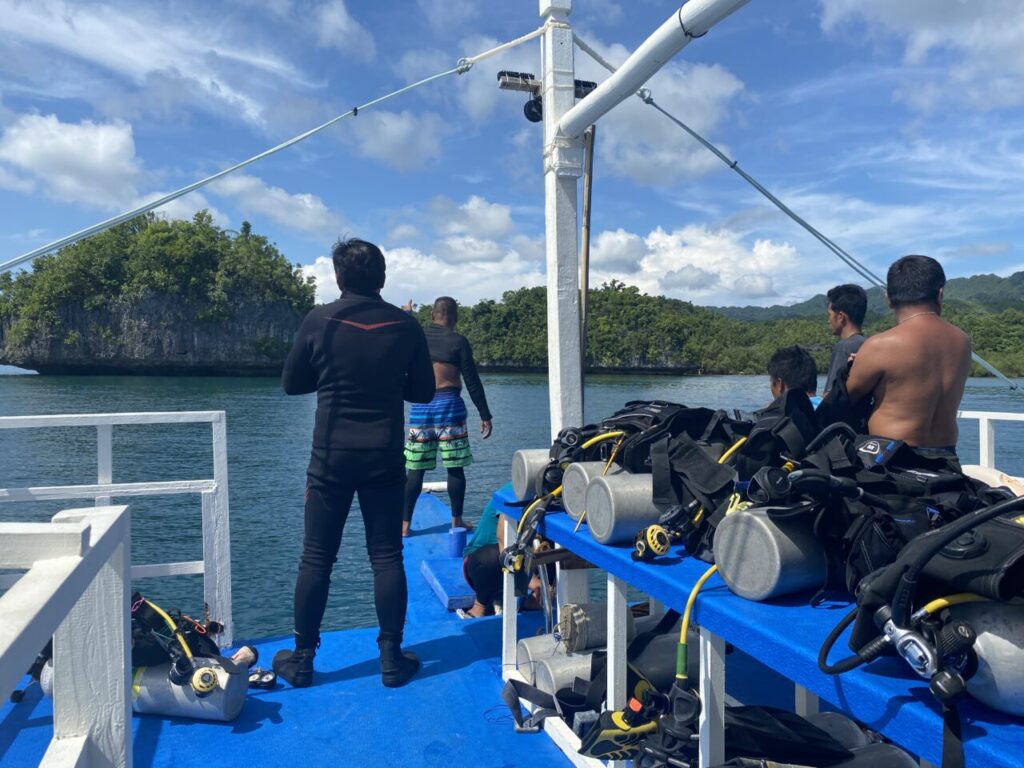
Getting In
When flying into the Philippines, you will almost definitely start in the country’s capital: Manila which is located on Luzon; the country’s largest and most northern island.
There are many different flights into the Philippines to choose from. If you’re flying there from within Asia, PhilippinesAirlines and AirAsia offer the cheapest deals although they can often be subject to delays. When checking out flight schedules and deals I tend to use Skyscanner.
From Manila, you can catch a connecting flight to the likes of Coron or El Nido (both in Palawan) or Cebu or Dumaguete in the Visayas region; all of which are excellent launch pads for exploring the rest of the Philippines. Or you can grab a 3 hour bus ride down to Anilao, one of the easiest dive destinations to reach and then take a 90 minute ferry to Puerto Galera.
When checking schedules of and booking ferries and busses around the Philippines I use 12Goasia.
Entry Requirements: Upon arrival, most nationalities can get a VISA for one month. If you want to stay longer, you can plan your visa extension in advance. Or you can visit an immigration office in Manila, Cebu, Bohol or Davao and do it there. Extending your visa this way is relatively easy, it costs around 10,000 pesos (about $180) to extend for 2 months and so on. There’s a 24 hour waiting period and you must do it 10 days before your current visa expires.
IMPORTANT NOTE: To enter the Philippines you have to have proof of a flight of onward travel! I suggest you book the cheapest outward flight possible, which is normally to somewhere like Kuala Lumpur or Bangkok and pay extra for cancellation option – then cancel it after getting there!
Getting Around
It’s so easy to get around the Philippines. There’s a vast network of bus routes around the larger islands; travelling via bus is very cheap and most buses tend to run every hour or so. In some cases theres vans instead of buses which are slightly more expensive but same gimmick – regular routes at affordable prices with the option to buy tickets up until departure.
Generally speaking, if you’re going there on a dive trip, you’ll probably find you do most of your travelling via ferry – once again, there are many ferries operating between the various islands of the Philippines with prices varying between about 700 – 1500 pesos and journeys lasting usually anywhere from 2 – 4 hours.
You can usually buy tickets right up until the point of departure, although there is sometimes a long que so booking in advance is a smart move. There’s usually ac on board these ferries and a small snack bar. Try to get a window seat as you get a scenic view of the various islands on many routes.
When it comes to checking schedules for and booking buses and ferries around the Philippines I heartily recommend 12Goasia!
Once you’re at any given destination, you have two options for getting around. You can opt for a tricycle or you can rent a scooter which is far more fun and usually saves you money if you’re exploring a lot.
In cheaper places such as Bohol daily cost for a scooter is 300 pesos a day; in more more expensive areas like Palawan it can be 500 pesos a day. Blasting around on a scooter is one of my favourite ways to explore!
Partying / Culture and Fun in the Philippines
Unlike the rest of Southeast Asia, the Philippines is a pretty westernised culture. The locals are almost always down to party, and usually fluent in english.
When you go drinking watch out for red horse beer, this stuff is insanely strong and will easily knock you off your feet if you’re not careful!
The san miguel pale pilsen and light are normal strength beer whereas the san miguel flavoured is very weak indeed, more like an alco-pop.
It’s pretty standard to get invited out for beers by most dive centres, especially if you’re there a couple of days! Go for it – filipinos are a lot of fun, a really decent bunch and you’ll make some awesome friends.
Karaoke is a favourite past time. In the Philippines karaoke means hiring a private booth and proceeding to belt out songs non-stop for two-three hours amidst towers of beer.
The Philippines is a mostly-christian country (with the exception of Mindanao in the south which has a large Muslim population) and there are many churches around the place including some very old ones from the Spanish colonial era, dating back hundreds of years.
There are a lot of clubs and bars in many Philippines destinations although do beware of drugs out there – it’s insanely illegal and stints where someone sells you weed only for it to be a police bust are common. Best case scenario you will have to pay a ridiculously high bribe, worst you could end up in prison for years all for having a tiny amount of weed on you.
However, if you do end up scoring; do not take any drugs on the ferry with you!! For every ferry I ever took, at the port everyone had to place their bags and luggage on the floor which was lined up and then a sniffer dog was bought up and down, passing each bag multiple times. This may also happen on long bus journeys. You also sometimes get sniffer dogs at the entrances of big malls.
In the Philippines, everyone loves meat, seafood and rice. It’s pretty damn hard scoring good vegetables and fruit around the place -they are out there there but less common, so you usually need a bit of time in any location before you can scout out the healthier places to eat. Don’t loose heart, those healthy dining options are out there…somewhere!
Street food is frigging delicious and worth eating. There’s all kinds of whacky things going off from chicken intestines, feet and livers, pig fat and more standard sticks of meat. This is really tasty eating and also very cheap. Balut is a right of passage; its’ a fertilised egg. Try not to look when you eat it and dip it in plenty of vinegar!
Sizzling pork sisig is a favourite and very delicious meal at restaurants – often you don’t get a huge amount on the plate, but is is so very tasty and consists of thin slices of (unrecognisable) pig face and liver along with (tiny) strips of vegetables served still sizzling away on an extremely hot (do not touch!) metal plate with a partially raw egg on top. There’s also loads of amazing sea food. Bangus bangus or milkfish is the national fish of the Philippines and immensely tasty. You get loads of fresh seafood markets with local fresh produce. Much tastiness.
Other Things to Do
The Philippines is simply an awesome place to travel for anyone who loves nature or adventure activities – there are so many cool things you can easily and cheaply do such as trekking, caving, cliff jumping, canyoneering, waterfalls, beach hopping, skydiving, kayaking, surfing…the list goes on and on!
What’s especially awesome is that so many of these activities are within easy reach of the prime diving destinations. I’ve provided more info on them within each of main guides for those destinations.
And of course, as we just covered, the Philippines is a great place to party! But it also doesn’t have to be…there are also some extremely tranquil, quiet and laid back locations where one can simply be in nature with tribal communities or laid-back bohemian vibes.
Philippines Diving FAQ
Do I have to be an Experienced Diver to Dive the Philippines?
No! Most Philippines diving destinations are beginner friendly – in fact many people get scuba certified there! The exception to this rule is Coron, where to explore the best shipwrecks you should have your advanced open water certification and wreck diving training. And Tubbataha reef for which you’ll also want to be an experienced diver.
Also, whilst most places in the Philippines are totally beginner friendly, the majority of dive destinations, do often have one or two more advanced dive sites such as drift or deep dives if you’re up for a thrill.
Is it Expensive?
Not really no! At around $35 per fun dive, it’s much cheaper than many other countries! The Philippines in general is also a cheap country to travel around, eat and stay in.
Where are the Best Places to Dive in the Philippines?
This comes down to a matter of personal preference! Something I really love about the Philippines is that each dive destination tends to offer a unique scuba experience – from incredible shipwrecks in Coron to amazing coral reef and whale sharks in Bohol to insane muck diving in Dumaguete and Anilao. Read the section above on the best diving destinations in the Philippines for more info.
I’m going to Travel around the Philippines for X Amount of Time. Where should I Dive?
That’s a great question! Although it’s pretty easy to get around the Philippines, when to comes to dive destinations, you definitely want to do them in a certain order to travel in the most efficient way. Check out the section on itineraries to find out more.
How do I Get Around the Philippines?
The main way to travel between Philippines dive destinations is via ferry, which are fairly cheap and run regularly. Check out the getting around section to find out more about this. Sometiems you may also need to fly – but make sure you don’t dive iwthin 24 hours of flying!
When is the Best Time to Dive the Philippines?
Technically you can dive most of the Philippines year round but for the best water conditions, when to go actually depends on where you go! Different areas have different dive seasons. Check out the section on Philippines Dive Season for more info.
Where are the Best Places to Stay for Divers in the Philippines?
Whilst this does of course come down to your budget and personal preferences, the best place to stay for divers in the Philippines are generally dive resorts or hostels with fun vibes and combined restaurants and bars.
For each of the best places to dive in the Philippines, I’ve actually included a separate article listing the best accommodation / resorts for divers there. And you can read about the all-time Best Philippines Dive Resorts here.
What Else is There To Do in the Philippines?
Hot dayum – so much! There’s a huge amount of adventure actives you can enjoy in the Philippines such as caving, waterfalls, trekking, beach hopping, partying, cliff jumping, surfing and more. In each destination guide I’ve included a section on extra activities for that place.
Philippines Diving Squad DEBRIEFING:
In this sheer whale shark of an article, we’ve covered an absolute f*ck ton in order to ensure you know absolutely everything – and I mean everything (!), that there is to know to get the very best out of your Philippines diving adventure – based on my own diving odysseys there in 2016, 2020 and 2023!
First we talked about why you should dive the Philippines in the first place and then I walked you through the best diving itineraries there for various lengths of trip.
This was then followed by an in-depth look at the 12 best places to dive in the Philippines, with links to more in-depth guides and accommodation listings for each one.
After that, I talked about my favourite Philippines dive resorts of all time and then I described getting in to the Philippines and then how to get around once your there!
This was followed by a look at partying and culture in the Philippines and then other things to do there and finally followed up up by a handy Diver’s FAQ section!
Finally, we find ourselves here at the article conclusion, having summarised everything we’ve gone over. I’ve actually written a helluva lot more about diving the Philippines! Check out the links below to find out more about some of my favourite dive destinations in the Philippines of all time:
